Recommended
Climate change will impact migration patterns. Numerous efforts have been made to quantify the scale and timelines of this impact. This is quite sensible. Policies are better when we know where their beneficiaries are, what their needs are, when these needs will arise, and how any intervention will affect other policy areas. But are we able to accurately predict the effects of climate on migration? And if not, what can be done?
What predictions do we have, and how reliable are they?
The desire to quantify the impact of climate change on migration has generated a mid-sized cottage industry, with their findings often grabbing media headlines. Table 1 provides an overview of the better-known predictions from academics, international organisations, and think-tanks.
Table 1. Overview of predictions
|
Source |
Number impacted |
Timeframe (by) |
Dimensions |
|---|---|---|---|
|
50 million |
2010 |
Cross-border, globally |
|
|
162 million |
2050 |
Cross-border, globally |
|
|
Baird et al. (2007) (Christian Aid) |
300 million |
2050 |
Internal |
|
Over 1 billion |
2050 |
Unclear |
|
|
World Bank Groundswell reports: Rigaud et al. (2018) and Clement et al. (2021) |
44 million – 216 million |
2050 |
Internal; variation depends on RCP followed[1]; does not cover all regions |
|
Elhabrouk (2022) (World Economic Forum) |
1.4 billion |
2060 |
Unclear |
|
1.2 million |
2050 |
Cross-border, within Africa |
|
|
47 million – 113 million |
2050 |
Internal, within Africa; variation depends on RCP followed |
While these predictions are made with good intentions, they suffer from major data shortfalls and methodological challenges. On the former, it is difficult to systematically attribute extreme weather events and their harms to climate change. Migration data, too, is inadequate at both the internal and international levels. Many studies use census data, which has large time intervals and cannot capture the shorter-term movement which often predominates; other approaches face difficulties of representativeness or comparability.
Different people will be affected differently
On the latter, the first challenge concerns the definition of a ‘climate migrant’. Working out whether existing migrants moved due to climate change is impossible, and assessing how trends might continue or change in the future is challenging. Migration is not mono-causally affected by climate change: political, cultural, and socio-economic factors matter more than environmental factors. Existing models have not yet begun to integrate the characteristics of people at risk of hazards, making them less accurate.
Instead, predictions either attempt to use previous migration patterns to give insight into future movements under different climatic scenarios, or crudely assume that a given proportion of those in ‘hotspots’ expected to be affected by increased climate extremes will move. These exposure models are used, for example, to predict future movement due to sea level rise, with varying results—including findings suggesting that migration will increase towards coasts.
We know that different populations will respond to similar shocks in different ways. In Patagonia, for example, some members of communities endangered by landslides prefer to remain where they are, even while other members leave. In some cases, a slow ‘tide’ of migration will accompany and interact with gradual environmental and social degradation. In others, a ‘tipping point’ will be reached that sees out-migration rapidly increase. In Somalia, temperature and rainfall anomalies are found to have outsize impacts on migration due to stressed ecological and socio-economic systems. Understanding in advance where, and when, these tides and tipping points will occur is extremely challenging. We also, of course, can’t predict future shocks. It is possible that growth in machine learning capabilities might make new approaches, incorporating non-linear outcomes, more feasible.
The role of adaptation
Humans will also be able to adapt to climate change, changing their behaviour to reduce its impacts on their wellbeing. Future local development and adaptation pathways are recognised to greatly affect migration choices and outcomes. Exactly how this occurs will vary across contexts. Within the field of Disaster Risk Reduction, there are two key axioms:
- Disasters are social, not environmental, processes;
- Disasters are caused by vulnerabilities, not by hazards.
This means that while hazards may increase –such as more frequent heavy rainfalls— vulnerabilities will not increase at the same pace in all circumstances. Responses to growing hazards, including mobility responses, will thus also not be uniform across spaces. The population of one coastal town may be highly vulnerable to a sea surge, and afterwards migrate to support lost livelihoods; another town a short distance up the coast may have constructed sea walls, and have little need to change their behaviours despite experiencing the same hazard. Responses can also vary across time. Vulnerability to a hazard may lead to migration at one point in time, but large investments mean that the same hazard produces a very different response a decade later.
For example, a study in China found that during from 1989-2011, responses to environmental events changed significantly. Prior to 2000, temperature anomalies increased permanent internal migration; after 2000, these effects were reversed. Poverty in China was declining during this period. As a result, household reliance on good weather for agricultural yields decreased, and vulnerability to temperature shocks went down. Instead of sending family members elsewhere as an insurance option—which can often be an excellent tool—households could instead remain together.
Currently, no predictive models account for adaptation. The World Bank’s seminal Groundswell report, for example, explicitly does not consider the effects of adaptation on migration. This throws a spanner in the works of any predictive effort. In any given place, a whole range of interventions—the arrival of heat-resistant crops, increased access to cheap solar power, or the installation of a new administration focused on good governance—could greatly increase resilience to hazards, reducing the need to move.
Systemic factors will also have major impacts on migration, such as outbreaks of conflict; new economic developments; and increasing availability of education. All of these will shape both aspirations to migrate and capabilities to do so. Schewel et al. give the example of a forecasting model focused on Nigeria predicting large migration flows to cooler northern areas, overlooking that people are currently fleeing from the north due to militant violence. Another macro-level forecasting effort predicts that the largest migration flow in the 21st century will be from India to China, which is unlikely given their current relationship. Indeed, border policy is recognised to be very important to the directions and sizes of migration flows, but border policy, like other factors, is hard to predict in advance.
Moving forward
A recent USAID assessment of modelling methods concluded that the effort to predict the effects of climate change on migration is “still in its infancy”, and that projections “should be seen as notional at best”. What can be done in the absence of reliable forecasts, and what can be done to improve forecasts?
Using forecasts
At the micro level, predictive models will be necessary, even if we know they are imperfect: they can generate plausible scenarios to be used for assessing options effects. But macro-level predictive models are currently not worth much. So what should policymakers do when they’re using forecasts?
-
Not afford current models full credence. Ongoing collaboration between policymakers and researchers will be essential, to create improved projections and to ensure that policymakers are aware of the large margins of uncertainty.
-
Prioritise the use of shorter-term and local projections, which tend to be more accurate than longer-term estimates or estimates covering larger populations and areas. Longer-term policy should be informed by and evaluated against scenario-based planning exercises incorporating climate shocks. Conducting cost-benefit analyses across various scenarios can help identify effective, efficient, interventions and foster more resilient policies.
-
Commission local projections of the same area or population over the same timeframe, allowing cross-comparison. So far, it is rare for there to be many local-level forecasts of the same area.
-
Avoid referring to the predictions of mass migration generated by some models. These are unreliable and likely only to both unnecessarily cause alarm, and risk, generating backlash against migrants. This should be avoided even when using this narrative to drum up support for aid.
Improving forecasts
Forecasts will never be perfect, but they can be improved, especially at the local level.
-
Invest in the quality and availability of population data. At the local level, new sources of data—such as data from mobile calls, social network sites, mobile money apps, and remote sensing—should be used to provide more granular insights into movement patterns. At the national level, support should be provided to census management, as larger-scale scenario creation will have to rely on this (often unreliable) data. Both national statistical bureaus and parallel initiatives, such as the IOM’s Displacement Tracking Matrix, need investment. The gathering of more qualitative data, relating for example to migrants’ reasons for movement in climate-affected contexts, should also be supported.
-
Develop climate data infrastructure. Many areas prone to debilitating weather shocks lack adequate weather station systems. This is especially the case in South America, Africa, and parts of Central Asia. In Africa, for example, only one in four weather stations in 2020 produced data meeting international standards.
-
Use new methodological approaches. Forecasts should prioritise the examination of climate impacts rather than climate factors, such as reductions in crop yield rather than a naïve use of temperature or precipitation. Predictive models should also attempt to incorporate non-linear relationships, recognising the role of tides and tipping points, using new machine learning approaches.
-
Incorporate heterogeneities where possible. Recognising that migration responses will vary across place, age, gender, income, and so on, researchers should attempt to go beyond macro-level, aggregated predictions. As Beyer et al. recommend, forecasting should go beyond purely spatial modelling to catch migration fluctuations across time periods: an identical shock will have a different effect at different moments. Efforts to map season-by-season migration versus climate should be preferred in many contexts.
There is, in short, much to be done. For the time being, policymakers should be aware of the large limitations of forecasts; prioritise local-level and short-term models; use models as sources of scenarios, rather than real predictions; and invest in supporting improvements. Beyond modelling, adaptation should be supported as best as possible, regardless of its anticipated impacts on migration, and new opportunities for adaptive migration should be made available to the vulnerable in shock-exposed areas, regardless of whether they are otherwise anticipated to migrate.
[1] RCP stands for Representative Concentration Pathway. These are scenarios created for the Intergovernmental Panel on Climate Change (IPCC) to model the effects of greenhouse gas concentration. RCPs are one way for researchers to describe how climate change might affect human and non-human processes.
Disclaimer
CGD blog posts reflect the views of the authors, drawing on prior research and experience in their areas of expertise. CGD is a nonpartisan, independent organization and does not take institutional positions.
Image credit for social media/web: Dibyendu / Adobe Stock






